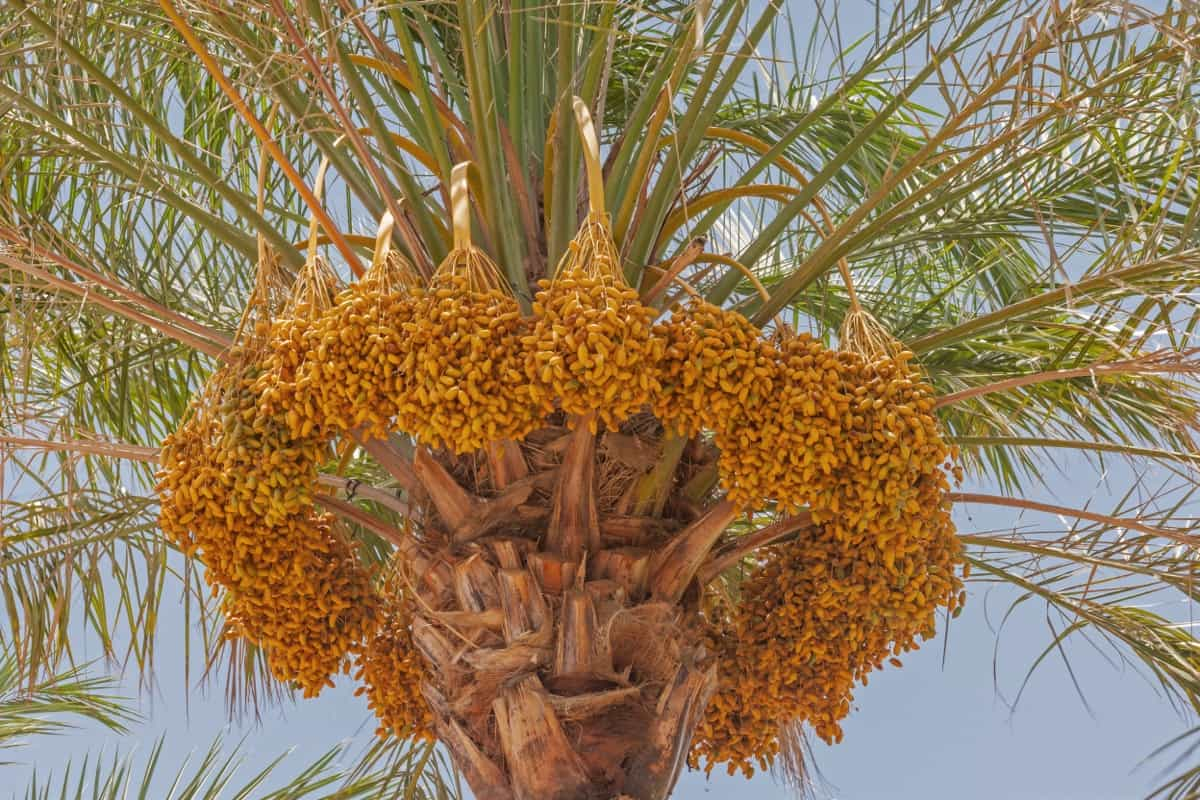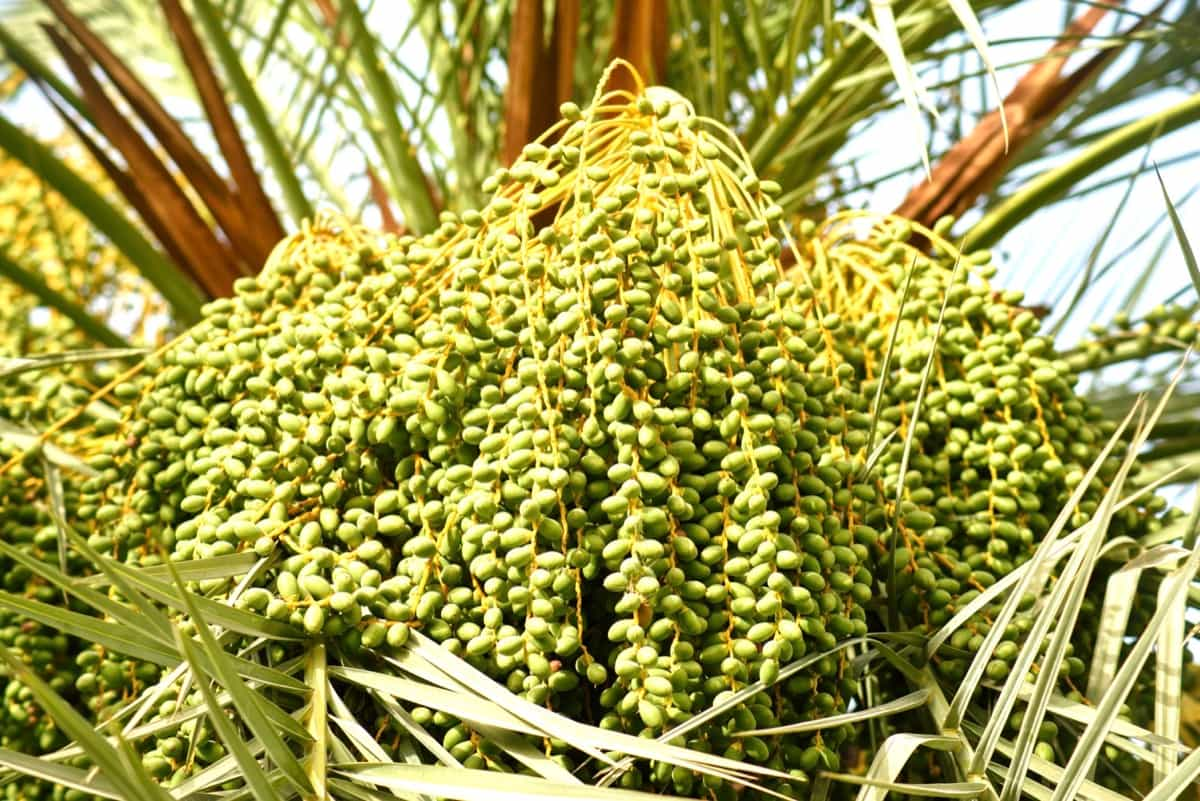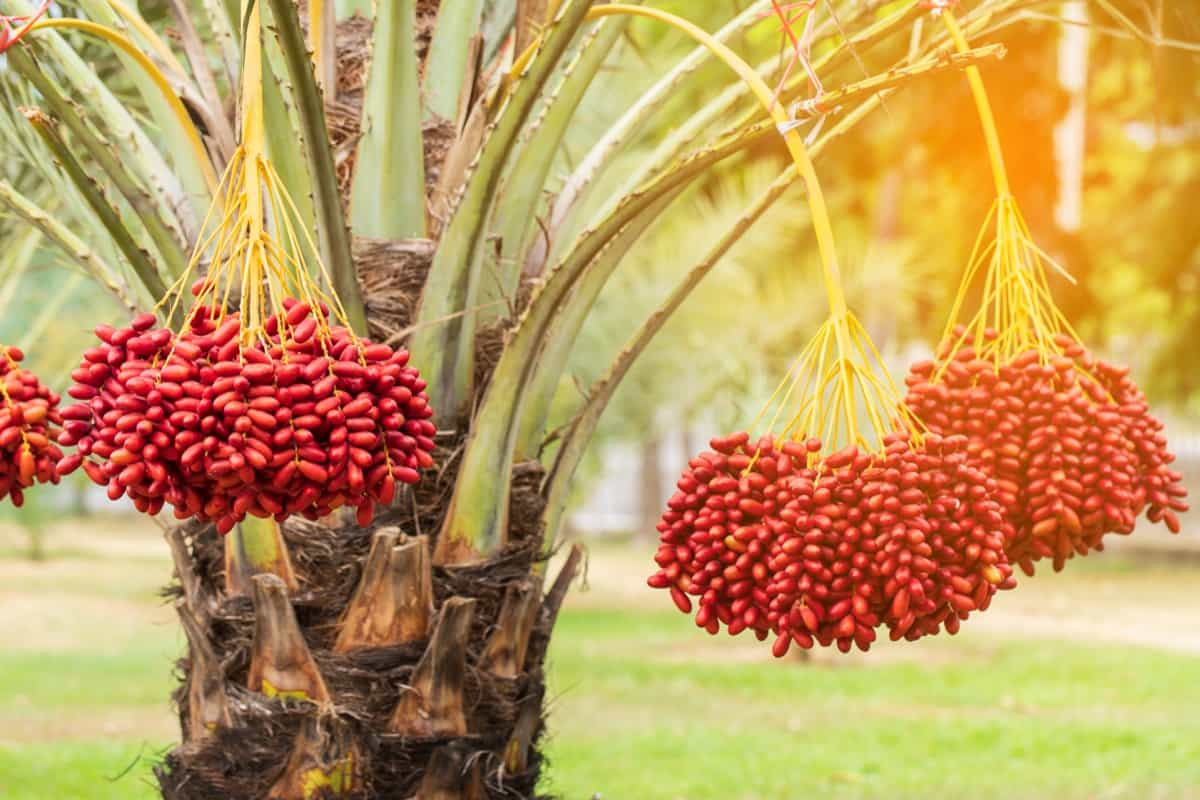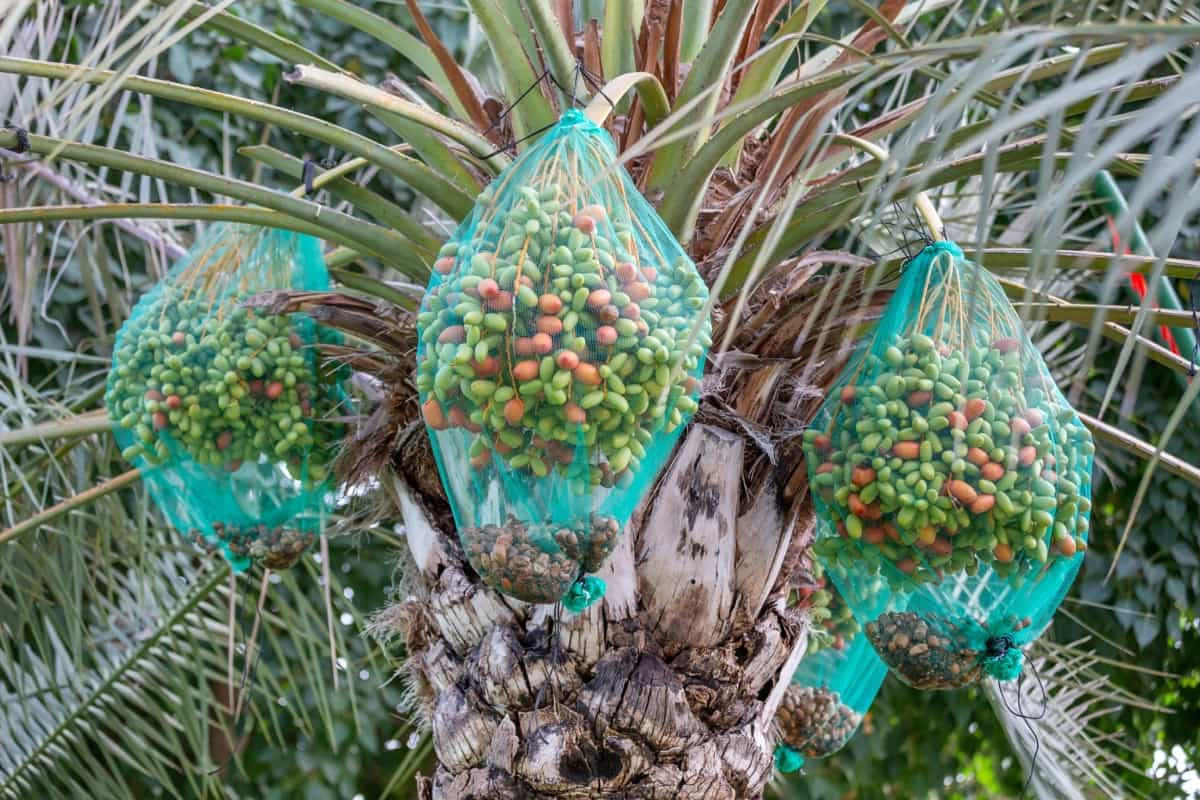Date Palms, scientifically known as Phoenix dactylifera, are magnificent trees that belong to the Arecaceae family. Fertilizing Date Palms is crucial for their optimal growth and yield. These majestic trees have specific fertilizer requirements that need to be met to ensure their health and productivity.

Date Palm Fertilizer Requirements and Recommendations
Best Organic Fertilizer for Date Palms
- Compost or well-rotted farmyard manure (FYM) are natural fertilizers rich in organic matter and slowly release nutrients. Apply 10-15 kg of FYM to young plants and increase it to 30-40 kg per tree for mature plants.
- Bone meal is high in phosphorus and helps tree growth. Phosphorus promotes root development and strengthens the overall structure of your Date Palm trees.
- Seaweed-based products can work wonders for a complete organic fertilizer solution. They supply essential nutrients like nitrogen, phosphorus, and potassium and contain trace elements vital for optimal growth.
- Suppose you want to go completely homemade with your fertilizer mix. In that case, you can create your blend using kitchen scraps (like fruit peels), coffee grounds, eggshells (for calcium), and even diluted urine as a nitrogen source.
- Remember that when choosing an organic fertilizer for your Date Palms, consider factors like nutrient content, soil type, climate conditions, and the age of your plants.
Effective Fertilizer Schedule for Date Palms
Date Palm farmers must follow an effective fertilizer schedule from September to October to ensure optimal growth and yield. Applying 10-15 kg of Farm Yard Manure (FYM) is recommended for young plants, while mature plants require a higher dosage of 30-40 kg per tree. This provides the necessary nutrients for healthy development.
In addition to FYM, urea is another important component of the fertilizer schedule. One-year-old plants up to mature trees should be treated with 4.4 kg of urea. The application should be divided into two equal splits to maximize its effectiveness. The first dose should be given before flowering occurs, while the remaining half should be applied after the fruit set takes place in April.
The proper application of fertilizers at specific stages of growth allows for efficient nutrient absorption by the Date Palm roots and enables them to thrive in various environmental conditions. Farmers need to adhere strictly to this fertilizer schedule as part of their management practices for successful Date Palm cultivation.
In case you missed it: Project Report of 1-Acre Date Palm Farming: Production Economics, Cultivation Cost and Profit

By following an effective fertilizer schedule, such as applying organic fertilizers like FYM and urea at specific times, you can ensure that your Date Palms receive the necessary nutrients for healthy development. Nitrogen, phosphorus, and potassium requirements are crucial to promote robust growth and fruit production.
Fertilizer Schedule for Date Palms
| Nutrients | Recommended dose |
| Farm Yard Manure | Applying 10-15kg of FYM is recommended for young plantApplying 30-40kg of FYM per tree for mature plants |
| Nitrogen | 300 kg per hectare |
| Phosphorus | 100 kg per hectare |
| Potassium | 300 kg per hectare |
Homemade Fertilizer for Date Palms
- Compost tea is a nutrient-rich liquid created by steeping compost in water and then straining the solids. The resulting liquid can be applied directly to the base of the Date Palm tree, boosting organic nutrients.
- Banana peels are packed with potassium, essential for healthy plant growth. Chop and bury a few banana peels around the tree’s base. Over time, as they decompose, they will release their valuable nutrients into the soil.
- Fish emulsion fertilizer by blending fish scraps or leftovers with water until smooth. This mixture can be poured onto the soil around your Date Palms to provide extra nitrogen and other important nutrients.
- Using homemade fertilizers saves money and reduces reliance on chemical-based products. Plus, it’s a great way to repurpose kitchen waste and promote sustainable gardening practices.
Nitrogen, Phosphorus, and Potassium Requirements for Date Palm Cultivation
- When it comes to nitrogen (N) requirements for Date Palm cultivation, the recommended portion is around 300 kg per hectare (h). Nitrogen is responsible for promoting leafy growth and overall plant vigor. It helps in the synthesis of proteins and enzymes that are vital for cell division and expansion.
- Phosphorus (P) is another important nutrient needed by Date Palms. The recommended portion for phosphorus is about 100 kg/hectare. Phosphorus aids in root development and improves the uptake of other essential nutrients.
- Potassium (K) is crucial for Date Palm cultivation as well. The recommended portion of potassium is approximately 300 kg/hectare. This nutrient helps regulate water movement within plants, enhances disease resistance, promotes flowering, and improves fruit quality.
- Maintaining a proper balance between these three nutrients is crucial to ensure healthy growth and maximum yield of Date Palms. However, it’s important to note that these recommendations may vary depending on soil conditions, climate factors, and specific cultivars.
In case you missed it: How to Grow and Care for Sago Palm: A Comprehensive Guide for Beginners

How to Fertilize Date Palm for Optimal Growth?
- Ensuring proper nutrition through fertilization plays a significant role in maximizing yield.
- Choosing the right fertilizer that provides the necessary nutrients for these trees. Look for a balanced fertilizer that contains nitrogen, phosphorus, and potassium – the three main macronutrients needed for healthy plant growth.
- To apply the fertilizer, dig small holes around the tree’s base and evenly spread the granules inside. Be sure not to pile them up against the trunk, which can cause damage. Once applied, gently work the fertilizer into the soil using a rake or your hands.
- It’s also crucial to follow a regular fertilization schedule throughout different stages of growth. Young Date Palms may require smaller amounts of fertilizer compared to mature trees. Generally, applying organic materials such as compost or well-rotted manure in early spring is beneficial.
- Remember that over-fertilization can be just as harmful as under-fertilization. Always follow recommended dosage instructions and avoid excessive use of chemical fertilizers which could lead to nutrient imbalances or environmental pollution.
Balancing pH Levels with Fertilizer for Date Palms
- The right pH balance ensures optimal nutrient availability and uptake by the plants. Different soils have different pH levels, and Date Palms thrive best in slightly alkaline soil with a pH range between 7.0 and 8.5.
- To achieve this balance, fertilizer plays a vital role. By choosing the right fertilizer formulation, you can effectively adjust and maintain the desired pH level for your Date Palms. Generally, organic fertilizers such as compost or well-rotted manure help to increase soil acidity over time due to their slow-release nature.
- On the other hand, using chemical fertilizers like ammonium-based ones can temporarily lower the soil’s pH level. However, it’s important to note that excessive use of chemical fertilizers can lead to imbalances and negatively impact plant growth.
- Regularly monitoring soil pH levels is key in maintaining proper balance throughout all stages of Date Palm growth – from seedling establishment to maturity. This will enable timely adjustments through targeted fertilizer applications if necessary.
Preventing Nutrient Deficiencies in Date Palm with Fertilizer
Nutrient deficiencies can lead to stunted growth, poor fruit quality, and decreased productivity. With the right fertilizer management practices, these issues can be easily prevented. Regular soil testing can help determine potential nutrient deficiencies or imbalances in your Date Palm orchard. Based on the results, you can tailor your fertilizer application accordingly to meet the specific needs of your trees.
Applying fertilizers at the correct time is equally important. Splitting nitrogen applications into two equal doses – one before flowering and another after fruit set – helps ensure a consistent supply throughout different stages of tree development. In addition to providing sufficient macro-nutrients like NPK, it’s also important to address micro-nutrient deficiencies that may occur. Iron (Fe), manganese (Mn), zinc (Zn), copper (Cu), boron (B), and molybdenum (Mo) are some micronutrients that play a critical role in Date Palm health and productivity.
In case you missed it: 1 Acre Oil Palms Cultivation Project Report in India: Production Cost and Profit

A well-balanced fertilizer program should include these micronutrients as well, either through foliar sprays or incorporated into soil amendments. Regular monitoring of leaf tissue analysis will help identify potential micronutrient deficiencies so they can be promptly addressed. Preventing nutrient deficiencies in Date Palms should also be a priority when maintaining Date Palm growth.
Conclusion
The success of Date Palm cultivation lies in providing the tree with the right amount and balance of nutrients throughout its growth cycle. Properly fertilized Date Palms bear more fruits and maintain good health throughout their lifespan. With careful attention to their unique fertilizer requirements, you can maximize crop yields while contributing to sustainable farming practices in Date Palm cultivation.
- Feed Your Flock for Less: Top 10 Tips to Save on Chicken Feed
- Ultimate Guide to Ossabaw Island Hog: Breeding, Raising, Diet, and Care
- Hatching Answers: The Top 10 Reasons Your Chickens Aren’t Laying Eggs
- Eggs and Economics: Breaking Down the Cost of Raising Backyard Chickens
- Defend Your Greens: Proven Methods to Keep Iguanas Out of Your Garden
- Ultimate Guide to Cinnamon Queen Chicken: A Comprehensive Guide for Beginners
- Ultimate Guide to California Tan Chicken: Breeding, Raising, Diet, Egg-Production and Care
- Ultimate Guide to Marsh Daisy Chicken: Breeding, Raising, Diet, and Care
- 10 Types of Chicken Farming Businesses You Can Start for Profits